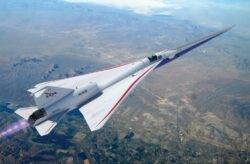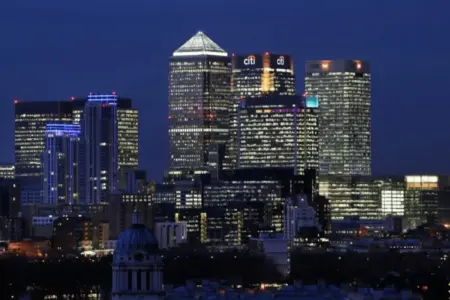Nasa’s X-59 supersonic plane is getting ready for take-off (Picture: Nasa/SWNS)
A ‘son of Concorde’ set to fly from New York to London in one and a half hours is a step closer to take-off – hopefully with a ‘supersonic thump’.
Nasa’s X-59 quiet supersonic passenger plane aims to fly faster than the speed of sound, at almost twice as fast as Concorde.
In preparation for its maiden voyage, the plane has been moved to the paint barn at Lockheed Martin Skunk Works’ facility in Palmdale, California, say the space agency.
And the paint job isn’t just for looks – it will provide vital protection as the plane blasts through the skies at up to 925mph.
Once painted, the team will take final measurements of its weight and exact shape to improve computer modelling and help reduce the sound of the typical sonic boom to a sonic thump, minimising disruption to people on the ground.
Nasa said in August they have identified potential passenger markets in about 50 routes between cities.
The supersonic jet could travel from London to New York in an hour and a half (Picture: Nasa/SWNS)
It is hoped one route would offer flights from New York City to London up to four times faster than normal jets.
‘The X-59’s paint scheme will include a mainly white body, a NASA “sonic blue” underside, and red accents on the wings,’ said Nasa in a statement.
The new paint job will help protect the plane as it travels at up to 925mph (Picture: Nasa/SWNS)
‘The paint doesn’t just add cosmetic value. It also serves a purpose – the paint helps to protect the aircraft from moisture and corrosion and includes key safety markings to assist with ground and flight operations.’
Cathy Bahm, the low boom flight demonstrator project manager, said: ‘We are incredibly excited to reach this step in the mission. When the X-59 emerges from the paint barn with fresh paint and livery, I expect the moment to take my breath away, because I’ll see our vision coming to life.
Engineers at Lockheed Martin working on the plane last year (Picture: Nasa/Lauren Hughes/SWNS)
‘The year ahead will be a big one for the X-59, and it will be thrilling for the outside of the aircraft to finally match the spectacular mission ahead.’
The aircraft is the centerpiece of Nasa’s Quesst mission, through which Nasa will fly the X-59 over several yet-to-be-selected US communities and gather data about people’s perceptions about the sound it makes.
Nasa hopes to turn down the jet’s supersonic boom to a supersonic thump (Picture: Nasa/SWNS)
Nasa will provide that data to regulators, which could potentially adjust current rules that prohibit commercial supersonic flight over land.
Earlier this year, the space agency investigated the business case for supersonic passenger air travel aboard aircraft that could theoretically travel between Mach 2 and Mach 4 (1,535 to 3,045mph at sea level).
By comparison, today’s larger airliners cruise at roughly 600mph, or about 80% of the speed of sound.
Concorde had a maximum cruising speed of 1,354mph, or Mach 2.04.
MORE : Star Wars plane could get you from London to New York in three hours
MORE : £160,000 flying car you have to build yourself sails through first flight
MORE : Ryanair plane flew ‘within 20 metres of an undetectable UFO’
It will fly faster than the speed of sound.





